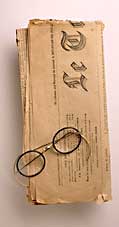The Print Media - 5 |
|
Newspapers Historical
Today, about 1,500 daily newspapers in the United States reach 130 million people. Weekly newspapers--many of which are free--have an even larger circulation, reaching 200 million people a week. At the same time, newspaper readership is not keeping pace with the increase in population. Today, only about half of the people in the United States read a daily newspaper. Even more significant to the future of newspapers, only about 30 percent of people under 36 years of age are reading a daily newspaper. This was not always the case. Thirty years ago, more than 60 percent of young people read a daily newspaper. As you can see from this graph, the majority of newspaper readers are age 50 and above. Recent research indicates that younger people are becoming less interested in news from any of the mass media — newspapers, newsmagazines, or television. Even so, 2004 figures indicate that readership among the top 813 newspapers had edged up 0.2 percent in the preceding year — but that still wasn't enough to keep up with population growth.
Although Japan has a much smaller population than the United States, it has a much greater share of newspaper readers. Many plausible reasons are given for this, but according to one writer in USA Today, "...the comparative dearth of U.S. newspaper readers is a direct result of our schools' inadequacy and inability to develop schoolchildren into easy readers or help them realize that world events can impact their lives and futures in important ways."
From their earliest days, newspapers have represented the nation's first historical record. At the same time, we have to take into account that the views of some newspapers are skewed toward their publishers and a niche audience. Some are considered liberal, some conservative, some pro-business--and a few champion fringe views. In order to survive, all newspapers must be responsive to the needs and interests of readers, as well as to the sensitivities of their advertisers. We'll discuss the future of newspapers later, but we need to start at the beginning in order to put things into perspective.
The earliest form of newspapers were called acta dirua (daily acts). They were hand written and posted by the Roman government in public places. That was 2,000 years ago. It wasn't until 1566 that publishers in Venice, Italy started selling actual newssheets--something that could be considered a rudimentary type of newspaper. The next development took place in 1665, when the first English newspaper, the Oxford Gazette, was published each week under the authority of the Crown. The first daily English newspaper was London's Daily Courant in 1702. As in the case of books, the idea of newspapers was brought to Among other things, it carried a story of the French King, who reportedly seduced his daughter-in-law. This caused a bit of a political rift, and not being all that concerned about finding out the truth of the matter before he acted, the governor of Massachusetts simply closed down the newspaper. After that questionable endorsement of an enfranchised press, it would be another 14 years before the next newspaper appeared. It was the Boston News-Letter, and the year was 1704. Under its nameplate it said, "Published by Authority." The "authority" was the post office, which was run by the governor's appointee, who, not surprisingly, saw that nothing was printed that detracted from the governor. As in the case of the first books in the colonies, most of the content of the Boston News-Letter was "borrowed" from Europe--mostly from the Oxford Gazette, in England, which by this time had been renamed the London Gazette. The process of copying news out of the Gazette meant that the "news" was often several months old before it appeared in the Boston News-Letter. Local news consisted of brief notes about ship arrivals, deaths, political appointments, court actions, sermons, and the activities of Indians and pirates. The next significant historical development was the start of Philadelphia's The American Weekly Mercury. Although it was an "authorized" publication, the publisher ended up in jail after saying that he hoped the General Assembly "will find some effectual remedy to revive the dying credit of the Province and restore us to our former happy circumstances." (Pretty subversive stuff in those days.) The next newspaper to appear--and the next person to end up in jail--was James Franklin, who published The New-England Courant in 1721. James, who was Benjamin Franklin's brother, languished in jail for a month. After getting out, he was forbidden to publish the Courant, or any paper "of like nature." But it always helps to have a capable brother. James turned over the publication of the Courant to brother Benjamin. Benjamin learned from his brother's experience and started writing under the pseudonym of Silence Dogwood; yes, Silence Dogwood! Benjamin Franklin had a talent for writing, and soon his work became popular. Although what he had to say upset some people--even to the point of having his life threatened--Franklin's talent in the newspaper business soon carried him into new publishing enterprises. He eventually became publisher of the highly regarded Pennsylvania Gazette. From here Franklin fathered a chain of newspapers, along with Poor Richard's Almanack, one of the first American magazines.
The next newspaper event of note took place when Peter Zenger began publishing the New York Weekly Journal in 1733. Zenger was arrested for seditious libel and slander after he supported a number of antiestablishment merchants who were opposed to the methods of the colonial governor. However, Zenger didn't "go peacefully into the night," he continued to edit his newspaper in jail and had his relatives print and deliver it. To make matters worse (for the governor) Zenger launched a court case against the slander charge. This got off to a bad start with two of Zenger's lawyers were disbarred for trying to have the judge removed from the case. The judge had been appointed by the same governor who had initiated the case, which, of course, represented something of a conflict of interest. Still not giving up, Zenger's friends then hired the eloquent lawyer Andrew Hamilton, who would later gain considerable fame in politics. Hamilton forcefully argued that "truth" was a valid defense for libel. Up to this time an article could be judged libelous and a person could be arrested and sent to jail--even if the article were totally true. The strength of Hamilton's argument rested on the concept that truth is essential to liberty, and that no person or institution should be able to stand in the way of truth. The concept seems self-evident, and it would later be one of the cornerstone concepts of the Bill of Rights.
In 1798, just seven years after the First Amendment to the Constitution was adopted that was designed to protect free speech from government interference, Congress passed the Alien and Sedition Acts. These were designed to severely limit the public's right to criticize the government, the President, or any member of the President's cabinet. Many people were jailed for violating the act. However, soon the public began to realize the price that was being paid for muzzling free speech. They reacted negatively, voting President John Adams, who had supported the act, out of office. Thomas Jefferson replaced Adams two years later. Not coincidentally, Jefferson had opposed the Alien and Sedition Acts. In the next module we'll finish the historical perspective on newspapers. |
|
|
|
To next module To
index © 1996 - 2005, All Rights Reserved.
|


 America from Europe during the Colonial Period. The first official colonial newspaper was Public Occurrences. However, the newspaper only had a one-day "history."
America from Europe during the Colonial Period. The first official colonial newspaper was Public Occurrences. However, the newspaper only had a one-day "history."